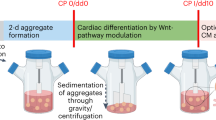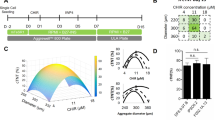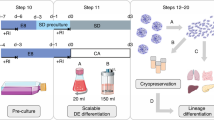Abstract
Cardiomyocytes (CMs) generated from human pluripotent stem cells (hPSCs) are a potential cell source for regenerative therapies, drug discovery and disease modeling. All these applications require a routine supply of relatively large quantities of in vitro–generated CMs. This protocol describes a suspension culture–based strategy for the generation of hPSC-CMs as cell-only aggregates, which facilitates process development and scale-up. Aggregates are formed for 4 d in hPSC culture medium followed by 10 d of directed differentiation by applying chemical Wnt pathway modulators. The protocol is applicable to static multiwell formats supporting fast adaptation to specific hPSC line requirements. We also demonstrate how to apply the protocol using stirred tank bioreactors at a 100-ml scale, providing a well-controlled upscaling platform for CM production. In bioreactors, the generation of 40–50 million CMs per differentiation batch at >80% purity without further lineage enrichment can been achieved within 24 d.
This is a preview of subscription content, access via your institution
Access options
Subscribe to this journal
Receive 12 print issues and online access
$259.00 per year
only $21.58 per issue
Buy this article
- Purchase on Springer Link
- Instant access to full article PDF
Prices may be subject to local taxes which are calculated during checkout







Similar content being viewed by others
References
Schwartz, S.D. et al. Human embryonic stem cell-derived retinal pigment epithelium in patients with age-related macular degeneration and Stargardt's macular dystrophy: follow-up of two open-label phase 1/2 studies. Lancet 385, 509–516 (2015).
Zweigerdt, R. Large scale production of stem cells and their derivatives. Adv. Biochem. Eng. Biotechnol. 114, 201–235 (2009).
Cantz, T., Sharma, A.D. & Ott, M. Concise review: cell therapies for hereditary metabolic liver diseases-concepts, clinical results, and future developments. Stem Cells 33, 1055–1062 (2015).
ViaCyte. A Safety, Tolerability, and Efficacy Study of VC-01™ Combination Product in Subjects With Type I Diabetes Mellitus. https://clinicaltrials.gov/ct2/show/NCT02239354 (23/03/2015).
Chong, J.J., et al. Human embryonic-stem-cell-derived cardiomyocytes regenerate non-human primate hearts. Nature 510, 273–277 (2014).
Lian, X. et al. Robust cardiomyocyte differentiation from human pluripotent stem cells via temporal modulation of canonical Wnt signaling. Proc. Natl. Acad. Sci. USA 109, E1848–E1857 (2012).
Lian, X. et al. Directed cardiomyocyte differentiation from human pluripotent stem cells by modulating Wnt/β-catenin signaling under fully defined conditions. Nat. Protoc. 8, 162–175 (2013).
Burridge, P.W. et al. Chemically defined generation of human cardiomyocytes. Nat. Methods 11, 855–860 (2014).
Burridge, P.W., Keller, G., Gold, J.D. & Wu, J.C. Production of de novo cardiomyocytes: human pluripotent stem cell differentiation and direct reprogramming. Cell Stem Cell 10, 16–28 (2012).
Mummery, C.L. et al. Differentiation of human embryonic stem cells and induced pluripotent stem cells to cardiomyocytes: a methods overview. Circ. Res. 111, 344–358 (2012).
Olmer, R. et al. Long term expansion of undifferentiated human iPS and ES cells in suspension culture using a defined medium. Stem Cell Res. 5, 51–64 (2010).
Singh, H., Mok, P., Balakrishnan, T., Rahmat, S.N. & Zweigerdt, R. Up-scaling single cell-inoculated suspension culture of human embryonic stem cells. Stem Cell Res. 4, 165–179 (2010).
Zweigerdt, R., Olmer, R., Singh, H., Haverich, A. & Martin, U. Scalable expansion of human pluripotent stem cells in suspension culture. Nat. Protoc. 6, 689–700 (2011).
Amit, M. et al. Dynamic suspension culture for scalable expansion of undifferentiated human pluripotent stem cells. Nat. Protoc. 6, 572–579 (2011).
Konze, S.A. et al. Cleavage of E-cadherin and β-catenin by calpain affects Wnt signaling and spheroid formation in suspension cultures of human pluripotent stem cells. Mol. Cell. Proteomics 13, 990–1007 (2014).
Wang, Y. et al. Scalable expansion of human induced pluripotent stem cells in the defined xeno-free E8 medium under adherent and suspension culture conditions. Stem Cell Res. 11, 1103–1116 (2013).
Beers, J. et al. Passaging and colony expansion of human pluripotent stem cells by enzyme-free dissociation in chemically defined culture conditions. Nat. Protoc. 7, 2029–2040 (2012).
Serra, M. et al. Improving expansion of pluripotent human embryonic stem cells in perfused bioreactors through oxygen control. J. Biotechnol. 148, 208–215 (2010).
Ting, S., Chen, A., Reuveny, S. & Oh, S. An intermittent rocking platform for integrated expansion and differentiation of human pluripotent stem cells to cardiomyocytes in suspended microcarrier cultures. Stem Cell Res. 13, 202–213 (2014).
Chu, L. & Robinson, D.K. Industrial choices for protein production by large-scale cell culture. Curr. Opin. Biotechnol. 12, 180–187 (2001).
Tolner, B., Smith, L., Begent, R.H. & Chester, K.A. Production of recombinant protein in Pichia pastoris by fermentation. Nat. Protoc. 1, 1006–1021 (2006).
Olmer, R. et al. Suspension culture of human pluripotent stem cells in controlled, stirred bioreactors. Tissue Eng. Part C Methods 18, 772–784 (2012).
Schroeder, M. et al. Differentiation and lineage selection of mouse embryonic stem cells in a stirred bench scale bioreactor with automated process control. Biotechnol. Bioeng. 92, 920–933 (2005).
Niebruegge, S. et al. Cardiomyocyte production in mass suspension culture: embryonic stem cells as a source for great amounts of functional cardiomyocytes. Tissue Eng. Part A 14, 1591–1601 (2008).
Niebruegge, S. et al. Generation of human embryonic stem cell-derived mesoderm and cardiac cells using size-specified aggregates in an oxygen-controlled bioreactor. Biotechnol. Bioeng. 102, 493–507 (2009).
Chen, V.C. et al. Scalable GMP compliant suspension culture system for human ES cells. Stem cell Res. 8, 388–402 (2012).
Lecina, M., Ting, S., Choo, A., Reuveny, S. & Oh, S. Scalable platform for human embryonic stem cell differentiation to cardiomyocytes in suspended microcarrier cultures. Tissue Eng. Part C Methods 16, 1609–1619 (2010).
Xu, X.Q., Soo, S.Y., Sun, W. & Zweigerdt, R. Global expression profile of highly enriched cardiomyocytes derived from human embryonic stem cells. Stem Cells 27, 2163–2174 (2009).
Hemmi, N. et al. A massive suspension culture system with metabolic purification for human pluripotent stem cell-derived cardiomyocytes. Stem Cells Transl. Med. 3, 1473–1483 (2014).
Fuerstenau-Sharp, M. et al. Generation of highly purified human cardiomyocytes from peripheral blood mononuclear cell-derived induced pluripotent stem cells. PloS ONE 10, e0126596 (2015).
Kempf, H. et al. Controlling expansion and cardiomyogenic differentiation of human pluripotent stem cells in scalable suspension culture. Stem Cell Rep. 3, 1132–1146 (2014).
Elliott, D.A. et al. NKX2-5(eGFP/w) hESCs for isolation of human cardiac progenitors and cardiomyocytes. Nat. Methods 8, 1037–1040 (2011).
Den Hartogh, S.C. et al. Dual-reporter MESP1mCherry/w–NKX2-5eGFP/w hESCs enable studying early human cardiac differentiation. Stem Cells 33, 56–67 (2015).
Wang, G. et al. Modeling the mitochondrial cardiomyopathy of Barth syndrome with induced pluripotent stem cell and heart-on-chip technologies. Nat. Med. 20, 616–623 (2014).
Zweigerdt, R., Gruh, I. & Martin, U. Your heart on a chip: iPSC-based modeling of Barth-syndrome-associated cardiomyopathy. Cell Stem Cell 15, 9–11 (2014).
Kensah, G. et al. Murine and human pluripotent stem cell-derived cardiac bodies form contractile myocardial tissue in vitro. Eur. Heart J. 34, 1134–1146 (2013).
Anderson, M.E., Goldhaber, J., Houser, S.R., Puceat, M. & Sussman, M.A. Embryonic stem cell-derived cardiac myocytes are not ready for human trials. Circ. Res. 115, 335–338 (2014).
Fluri, D.A. et al. Derivation, expansion and differentiation of induced pluripotent stem cells in continuous suspension cultures. Nat. Methods 9, 509–516 (2012).
Huang, S.X. et al. The in vitro generation of lung and airway progenitor cells from human pluripotent stem cells. Nat. Protoc. 10, 413–425 (2015).
Lachmann, N. et al. Large-scale hematopoietic differentiation of human induced pluripotent stem cells provides granulocytes or macrophages for cell replacement therapies. Stem Cell Rep. 4, 282–296 (2015).
Hannan, N.R.F., Segeritz, C.P., Touboul, T. & Vallier, L. Production of hepatocyte-like cells from human pluripotent stem cells. Nat. Protoc. 8, 430–437 (2013).
Sgodda, M. et al. Improved hepatic differentiation strategies for human induced pluripotent stem cells. Curr. Mol. Med. 13, 842–855 (2013).
Siller, R., Greenhough, S., Naumovska, E. & Sullivan, G.J. Small-molecule-driven hepatocyte differentiation of human pluripotent stem cells. Stem Cell Rep. 4, 939–952 (2015).
Pagliuca, F.W. et al. Generation of functional human pancreatic beta cells in vitro. Cell 159, 428–439 (2014).
Katsirntaki, K. et al. Bronchoalveolar sublineage specification of pluripotent stem cells: effect of dexamethasone plus cAMP-elevating agents and keratinocyte growth factor. Tissue Eng. Part A 21, 669–682 (2015).
Hartung, S. et al. Directing cardiomyogenic differentiation of human pluripotent stem cells by plasmid-based transient overexpression of cardiac transcription factors. Stem Cells Dev. 22, 1112–1125 (2013).
Haase, A. et al. Generation of induced pluripotent stem cells from human cord blood. Cell Stem Cell 5, 434–441 (2009).
Acknowledgements
We thank A. Franke and D. Robles-Diaz for their excellent technical assistance; A. Haase for providing the induced pluripotent cell lines; and D.A. Elliott for providing the HES3 NKX2-5eGFP/w cell line. We thank Eppendorf for providing the cyclic perfusion script, impeller prototypes and comprehensive bioreactor schematic. This work was funded by the Cluster of Excellence REBIRTH (DFG EXC62/3; ZW 64/4-1, MA2331/16-1), the German Ministry for Education and Science (BMBF; grant no. 13N12606) and StemBANCC (support from the Innovative Medicines Initiative joint undertaking under grant agreement no. 115439-2, whose resources are composed of financial contribution from the European Union (FP7/2007-2013) and European Federation of Pharmaceutical Industries and Associations (EFPIA) companies' in-kind contribution).
Author information
Authors and Affiliations
Contributions
H.K., R.O. and R.Z. designed the experiments; H.K., C.K. and R.O. performed the experiments and analyzed the data; H.K., C.K. and R.Z. wrote the manuscript; U.M and R.Z. supervised the project; and all authors approved the final paper.
Corresponding author
Ethics declarations
Competing interests
The authors declare no competing financial interests.
Supplementary information
Supplementary Data
The cyclic perfusion script for the DASbox Mini Bioreactor System. The script controls automatic interruption of the stirring before the medium exchange. (TXT 2 kb)
Rights and permissions
About this article
Cite this article
Kempf, H., Kropp, C., Olmer, R. et al. Cardiac differentiation of human pluripotent stem cells in scalable suspension culture. Nat Protoc 10, 1345–1361 (2015). https://doi.org/10.1038/nprot.2015.089
Published:
Issue Date:
DOI: https://doi.org/10.1038/nprot.2015.089
This article is cited by
-
Matrix-free human pluripotent stem cell manufacturing by seed train approach and intermediate cryopreservation
Stem Cell Research & Therapy (2024)
-
AMPK activator-treated human cardiac spheres enhance maturation and enable pathological modeling
Stem Cell Research & Therapy (2023)
-
Continuous human iPSC-macrophage mass production by suspension culture in stirred tank bioreactors
Nature Protocols (2022)
-
Cardiac Organoids: A 3D Technology for Modeling Heart Development and Disease
Stem Cell Reviews and Reports (2022)
-
Generation of heart-forming organoids from human pluripotent stem cells
Nature Protocols (2021)
Comments
By submitting a comment you agree to abide by our Terms and Community Guidelines. If you find something abusive or that does not comply with our terms or guidelines please flag it as inappropriate.



